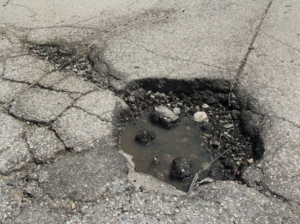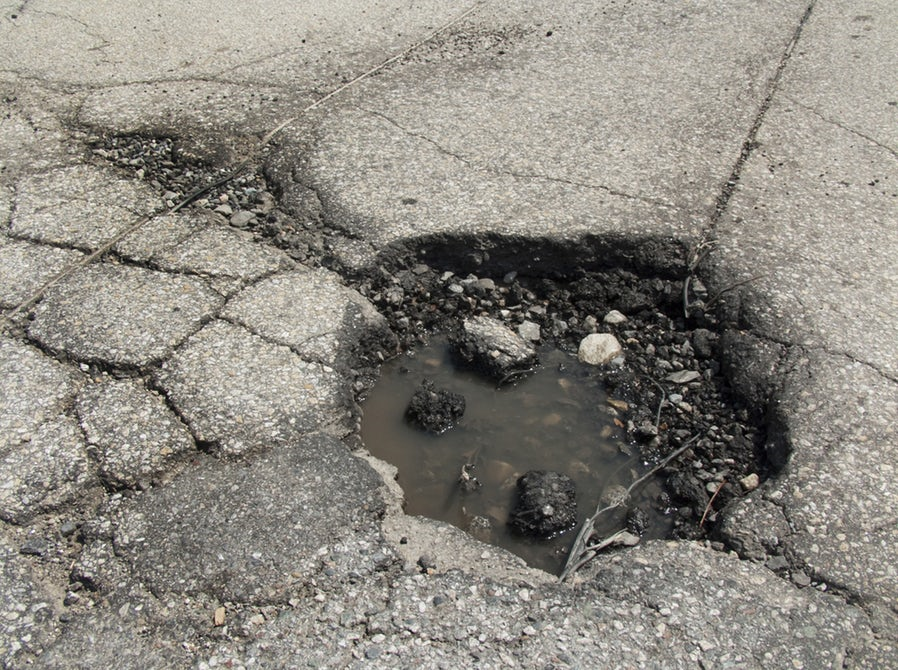
AH, Springtime in New England!
 We love to see those warm, spring days as we emerge from winter. But springtime in New England brings an unwanted consequence: potholes!
We love to see those warm, spring days as we emerge from winter. But springtime in New England brings an unwanted consequence: potholes!
In the worst-case scenario, hitting a pothole can result in a tire blowout or bent wheel. But even in non-catastrophic impacts add up over time and have a negative impact on your vehicle:
- Wheel misalignment (causing premature tire wear)
- Wear/damage to shocks and struts and cv axles
- Bent/broken suspension components (ball joints, tie rods, sway bar links, etc.)
With winter firmly fixed in your rearview mirror, you can now turn your attention to getting your car ready for the warmer months. One of the first things to do is rid your vehicle of road salt and grime buildup, restoring it to its proper luster with a wash and wax. You also need to consider possible damage to the vehicle due to rough road surfaces. Damage from potholes isn’t always easy to spot. If you suspect your vehicle may have suffered pothole damage, pay attention to warning signs while you’re driving.
EPISODE NOTES
In this episode, John talks with Rich about the pothole season and the affects hitting them has on your vehicle. Great tips on the warning signs you should look out for after you hit one.
WHAT IS A POTHOLE?
It starts out as a frost heave where the water under the pavement freezes and expands the pavement up above the road surface. Then in the spring when the ground begins to thaw out a pothole forms. A pothole is a small crevice or hole in the road caused by water from melted snow and ice permeating the pavement, thereby softening it. As a result of successive cold spells, the water refreezes, then expands, causing the underlying pavement to separate. The resulting gaps in the pavement and additional moisture seeping in weaken it further. With each passing vehicle, the pavement begins to separate more. Finally, with traffic continuing to cross the broken section, pieces of the roadway get kicked out, leaving a hole in its place. If you could observe the hole from its sides, it usually resembles a pot, thus the name pothole.
WHAT’S YOUR DAMAGE?
As you might imagine, driving over a pothole is never a good thing for any vehicle. Your tires make the first contact, which could lead to a blowout or cause rim damage. Less obvious, at least initially, is damage to your vehicle’s suspension system. Some of these telltale signs are as follows:
- Your vehicle sits lower at the front or the rear. If this is the case, one or both shock absorbers or the coil springs may have become damaged. This same problem can also occur while accelerating.
- Your vehicle no longer stays planted on twisty roads. You know how your vehicle behaves on curvy roads. Anything out of the ordinary, such as bouncing and sliding as you attempt to keep it centered in your lane, suggests a problem with the suspension. Rolling or swaying on turns is another troubling sign.
- Your vehicle’s front end “dives” when you brake. When you apply the brakes, your car should stop without drama. If it takes a bow before it comes to a stop, you could be dealing with front-end suspension damage.
- Your vehicle loses directional control during sudden stops or bottoms out when it hits a bump. Any time you sense that you’re losing control of your vehicle, that’s a clear sign something is desperately wrong. The first problem may have to do with the suspension and the steering gear or rack. The second problem is definitely a suspension issue.
Physical signs of pothole damage include dents and rust, which may, on closer inspection, reveal a problem with a shock, strut, bushings, bearings, joints, linkages and other suspension parts. These can work loose and damage the car’s body.
In the worst-case scenario, hitting a pothole can result in a tire blowout or bent wheel. But even in non-catastrophic impacts add up over time and have a negative impact on your vehicle:
- Wheel misalignment (causing premature tire wear)
- Wear/damage to shocks and struts and cv axles
- Bent/broken suspension components (ball joints, tie rods, sway bar links, etc.)
- Your exhaust system could break
- Your engine – or at least the oil pan – could sustain damage.
Whatever the problem detected, take care of it immediately to avoid further damage or a serious accident. Come in to Auto Care Plus immediately and click on this link for our Pothole Special!



